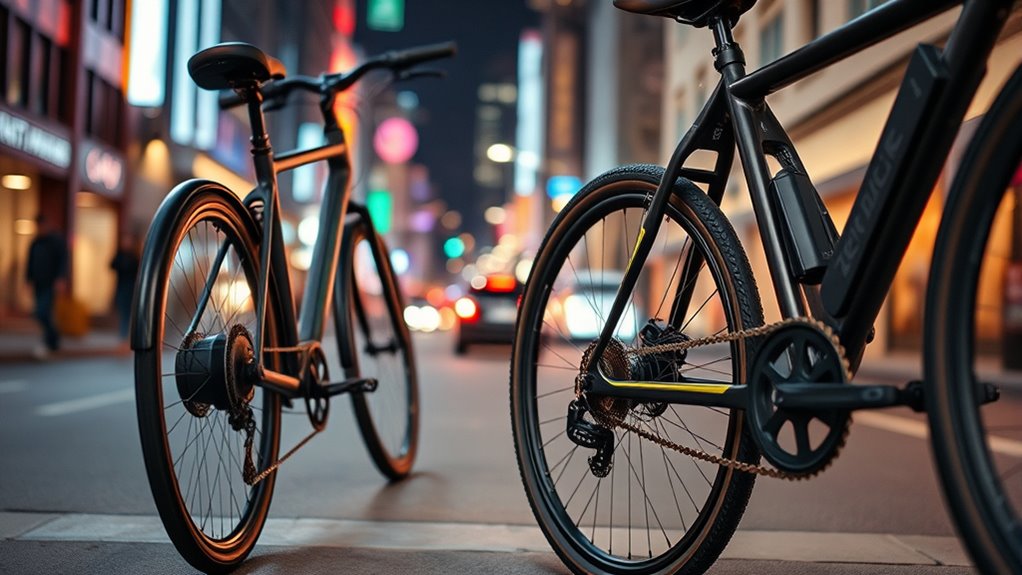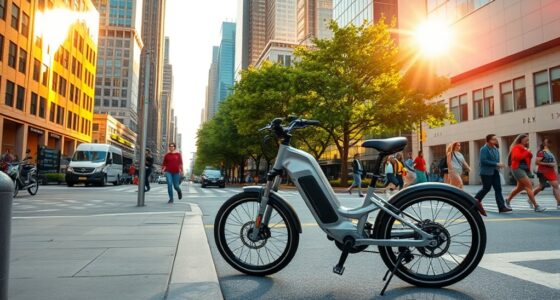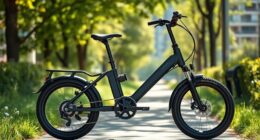For urban commuting, hub motors offer low maintenance, balanced handling, and better durability since they’re protected within the wheel hub, ideal for city rides. Mid-drive motors provide improved weight distribution and efficiency, but may require more upkeep and expose components to dirt and impacts. Your choice depends on whether you prioritize simplicity and reliability or performance and handling. To explore which option suits your commute best, you’ll find useful insights ahead.
Key Takeaways
- Hub motors are integrated into the wheel hub, offering lower maintenance and better protection from dirt and debris.
- Mid-drive motors are positioned near the bottom bracket, providing improved weight distribution and stability.
- Hub motors maintain balanced handling ideal for urban environments and are generally more durable.
- Mid-drive systems may require more upkeep but can deliver better performance and efficiency.
- Battery placement affects handling; hub motor batteries are easier to access, while mid-drive batteries are often integrated into the frame for stability.

Are hub motors or mid-drive motors better suited for your electric bike? When choosing between the two, one of the key factors to deliberate is battery placement. Hub motors are typically integrated into the wheel hub, which means the battery is usually mounted on the rear or front rack, or sometimes in the downtube. This placement keeps the weight centralized around the wheel, making the bike feel balanced and easy to handle during urban commutes. On the other hand, mid-drive motors are located near the bottom bracket, with the battery often mounted on the downtube or integrated into the frame. This setup shifts some weight lower and central, enhancing stability and giving your bike a more natural feel. The placement of the battery influences not just weight distribution but also how easy it is to access and replace the battery. Hub motor batteries tend to be more straightforward to remove, especially if mounted on a rear rack, making maintenance simpler. Mid-drive batteries can sometimes be more integrated, which offers a cleaner aesthetic but might require more effort to access and replace.
When it comes to maintenance requirements, hub motors generally demand less ongoing upkeep. Since they are housed within the wheel hub, they’re protected from dirt, water, and debris, reducing wear and tear. The motor components are largely sealed, so you don’t need to worry about frequent servicing beyond standard checks. In contrast, mid-drive motors, being positioned near the chain and gears, are exposed to more dirt, grime, and potential impacts from road debris. This exposure can lead to increased maintenance needs, such as regular cleaning and lubrication of the chain and drivetrain components. Additionally, because mid-drive motors are integrated into the bike’s frame, they might require more specialized servicing if issues arise, which could be more costly and time-consuming.
In urban environments, where reliability and ease of maintenance are essential, hub motors stand out due to their durability and lower upkeep needs. They also tend to be lighter and simpler to repair if something goes wrong. Mid-drive motors, while offering advantages like better weight distribution and efficiency, need a bit more attention and care, especially with the drivetrain components. Ultimately, your choice depends on your priorities: if you prefer a low-maintenance, balanced ride, a hub motor with its straightforward battery placement might be the better option. But if you’re willing to handle a bit more upkeep for improved performance, a mid-drive system could serve you well.
Frequently Asked Questions
Which Motor Type Is More Cost-Effective Long-Term?
When considering cost-effectiveness long-term, you need a solid cost analysis. Hub motors typically have a lower initial investment, making them more affordable upfront. However, mid-drive motors may offer better durability and efficiency, saving you money on maintenance over time. Think about your riding habits and maintenance costs to decide which motor type truly provides better value for your urban commute.
How Do Maintenance Needs Differ Between Hub and Mid-Drive Motors?
Maintenance needs differ like night and day. Hub motors generally require less upkeep because they have fewer moving parts, but you should still check the brake system and tire wear regularly. Mid-drive motors, on the other hand, put more strain on your chain, gears, and brake system, leading to more frequent maintenance. Keep an eye on tire wear and brake performance to keep your ride smooth and reliable.
Are There Specific Legal Restrictions for Each Motor Type?
Legal restrictions vary depending on your location, so you should verify local laws about motor types. Some areas require motor registration for higher-powered bikes, especially with mid-drive motors that often have more power. Hub motors may face fewer restrictions if they stay below certain wattage limits. Always make sure your bike complies with local regulations to avoid fines or the need for special licensing.
How Does Motor Type Impact Battery Life and Range?
Imagine your bike’s heart guiding your ride smoothly. Your motor type influences battery efficiency and range optimization, with hub motors often providing simpler, consistent power that conserves energy, leading to longer rides. Mid-drive motors, while offering more power, may drain batteries quicker due to increased demands on the system. Your choice impacts how far you can go, so consider your commuting needs to balance power and battery life effectively.
Can Both Motor Types Handle Steep Hill Climbs Equally Well?
Both motor types can handle hill climbs, but mid-drive motors generally excel because of their higher torque and better weight distribution. If you frequently tackle steep hills, you’ll notice mid-drives provide more power and efficiency during hill climbing. Hub motors may struggle a bit, especially on very steep inclines, because they usually have less torque. So, for challenging hills, mid-drive motors are your best choice.
Conclusion
Ultimately, choosing between hub and mid-drive motors depends on your commute needs. Hub motors are simpler and often more affordable, making them ideal for flat terrains and casual rides. Mid-drive motors offer better performance on hills and rough terrain, giving you more control. While some believe mid-drives are always superior, recent advancements show hub motors can be just as effective for urban commuting. Test both to see which truly fits your riding style and terrain.









